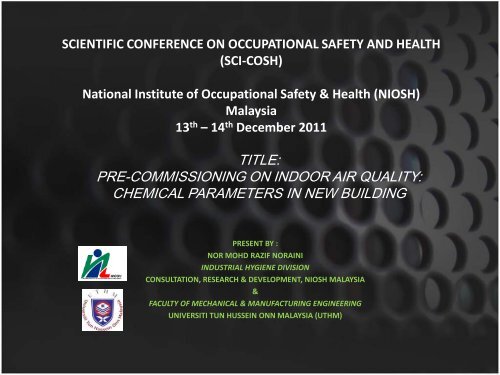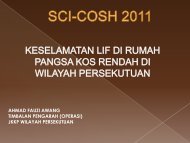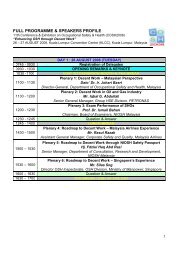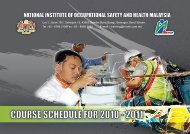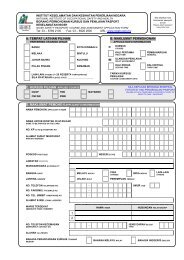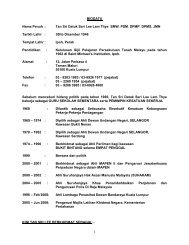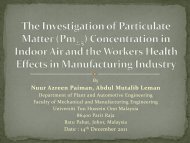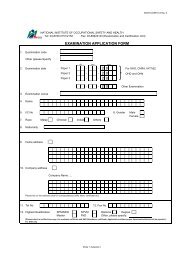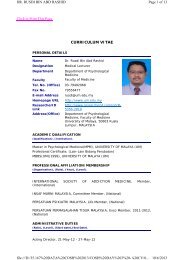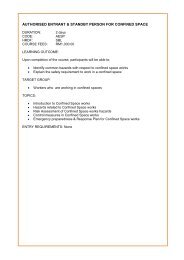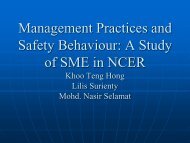Paper 12 - Pre-commissioning on indoor air quality - NIOSH
Paper 12 - Pre-commissioning on indoor air quality - NIOSH
Paper 12 - Pre-commissioning on indoor air quality - NIOSH
You also want an ePaper? Increase the reach of your titles
YUMPU automatically turns print PDFs into web optimized ePapers that Google loves.
SCIENTIFIC CONFERENCE ON OCCUPATIONAL SAFETY AND HEALTH(SCI-COSH)Nati<strong>on</strong>al Institute of Occupati<strong>on</strong>al Safety & Health (<strong>NIOSH</strong>)Malaysia13 th – 14 th December 2011TITLE:PRE-COMMISSIONING ON INDOOR AIR QUALITY:CHEMICAL PARAMETERS IN NEW BUILDINGPRESENT BY :NOR MOHD RAZIF NORAINIINDUSTRIAL HYGIENE DIVISIONCONSULTATION, RESEARCH & DEVELOPMENT, <strong>NIOSH</strong> MALAYSIA&FACULTY OF MECHANICAL & MANUFACTURING ENGINEERINGUNIVERSITI TUN HUSSEIN ONN MALAYSIA (UTHM)
CONTENT1. The introducti<strong>on</strong> to Indoor Air Quality, safety and healthissues in Malaysian industries and related activities;• Study Background and problem statement.• The goal and research objectives are stated.2. Literature Review• Existing research study in IAQ field (reference)3. Methodology• Standards used• Sample (Case study)• Research Instruments4. Results5. C<strong>on</strong>clusi<strong>on</strong>
INTRODUCTION• Indoor <strong>air</strong> <strong>quality</strong> (IAQ) is a term referring to the <strong>air</strong> <strong>quality</strong> within and aroundbuildings and structures, especially as it relates to the health and comfort ofbuilding occupants.IAQ can be affected by microbial c<strong>on</strong>taminants (mold, bacteria), gases (includingcarb<strong>on</strong> m<strong>on</strong>oxide, rad<strong>on</strong>, volatile organic compounds), particulates, or any massor energy stressor that can induce adverse health c<strong>on</strong>diti<strong>on</strong>s.• The Nati<strong>on</strong>al Health and Medical Research Council (NHMRC) defines;“<strong>indoor</strong> <strong>air</strong> as <strong>air</strong> within a building occupied for at least <strong>on</strong>e hour by people ofvarying states of health”This can include the office, classroom, transport facility, shopping centre, hospitaland home.
CONT…• The primary methods for improving <strong>indoor</strong> <strong>air</strong> <strong>quality</strong> in most buildingsare by using ventilati<strong>on</strong> to dilute c<strong>on</strong>taminants, filtrati<strong>on</strong>, and sourcec<strong>on</strong>trol.• IAQ problems occur in buildings that are served by a comm<strong>on</strong>ventilati<strong>on</strong> and/or <strong>air</strong> c<strong>on</strong>diti<strong>on</strong>ing system. IAQ problems can be due to<strong>indoor</strong> <strong>air</strong> pollutants or to inadequate ventilati<strong>on</strong>.• There are many sources of <strong>indoor</strong> <strong>air</strong> pollutants and am<strong>on</strong>g thecomm<strong>on</strong> <strong>on</strong>es are envir<strong>on</strong>mental tobacco smoke (ETS) emitted due toburning of tobacco products; various chemical substances such asformaldehyde emitted from furnishings; volatile organic compoundsemitted from the use and applicati<strong>on</strong> of solvents; and oz<strong>on</strong>e emittedfrom photocopiers and laser printers. It should be noted here that ETShas been recognized as a human carcinogen by the Internati<strong>on</strong>alAgency fro Research <strong>on</strong> cancer (IARC) in 2002 and exposure to it willincrease the risk of cor<strong>on</strong>ary heart disease.• Determinati<strong>on</strong> of IAQ involves the collecti<strong>on</strong> of <strong>air</strong> samples, m<strong>on</strong>itoringhuman exposure to pollutants, collecti<strong>on</strong> of samples <strong>on</strong> buildingsurfaces and computer modeling of <strong>air</strong> flow inside buildings.
STUDY BACKGROUNDIndoor Air Polluti<strong>on</strong>: The Silent Killer5The number of industrial accidentoccurrence is the MAJOR INDICATOR forevaluati<strong>on</strong> of the occupati<strong>on</strong>al safety andhealth (OSH) Legislati<strong>on</strong>, Program andResearch & Development c<strong>on</strong>ducted inMalaysia
RESEARCH PROBLEMAccording to Social Security Organizati<strong>on</strong> (SOCSO) Malaysiareport, there are significant problems c<strong>on</strong>cerning WORKINGENVIRONMENT (I.E ENVIRONMENTAL FACTORS:LIGHTING, VENTILATION, TEMPERATURES AND NOISE)The statistic for accident causes related to work envir<strong>on</strong>mentshow;YEARNUMBER OF CASESREPORTEDYear 2006 20,430REMARK1 st year after Code of Practise <strong>on</strong>Indoor Air Quality Published by DOSHMalaysia (2005)Year 2007 18,395 1.11% ReduceYear 2009 16,058 1.15% Reduce
DO WE REALIZE????....•Indoor Air is anywhere 2 to 10 timesMORE HAZARDOUS than outdoor <strong>air</strong>•People Spending an average 90% of theirtime inside rather than outside•Indoor Air Quality is the number <strong>on</strong>eenvir<strong>on</strong>mental health problem in USHOW ABOUT MALAYSIA??Source : Envir<strong>on</strong>mental Protecti<strong>on</strong> Agency (EPA)
CONCEPT AND RESEARCH IDEAWHY NEW BUILDING????......(EGLISH PROVERB)9
Adapted from: http://www.nati<strong>on</strong>alarchives.gov.uk/pathways/citizenship/brave_new_world/docs/health_poster.htm(Ministry of Health)
RESEARCH OBJECTIVESThe main objectives of the research are follows:-1. To measure the five (5) Indoor Air Quality (IAQ) ofchemical parameters during <str<strong>on</strong>g>commissi<strong>on</strong>ing</str<strong>on</strong>g> of newbuilding.2. To identify the IAQ data differences for different levelsof the building and compare with the standard of IAQ inMalaysian practice.3. To produce a baseline data for future development ofguideline/protocol to support assessment andm<strong>on</strong>itoring program of IAQ <str<strong>on</strong>g>commissi<strong>on</strong>ing</str<strong>on</strong>g> for newbuilding in Malaysia.
LITERATURE REVIEW – A SURVEYSome of the research c<strong>on</strong>ducted are follows:-1. Development And Applicati<strong>on</strong> Of An Indoor Air QualityCommissi<strong>on</strong>ing Program In A New Office Building (W. Stuart Dols,Steven J. Nabinger,Andrew K. Persily, (1994))2. Indoor Air Quality in New Hotels Guest Rooms of The Major WorldFactory Regi<strong>on</strong> (Wilco Chan, Shun-Cheng Lee, Youming Chen,Barry Maka, Kevin W<strong>on</strong>ga, Chi-Sing Chan, C<strong>on</strong>g Zheng, XingguoGuo (2008)/ELSEVIER/Internati<strong>on</strong>al Journal of HospitalityManagement 28 (2009) 26–32)3. Impact of Regulati<strong>on</strong> On Indoor Volatile Organic Compounds InNew Unoccupied Apartment In Korea (Soogil Lim, Kiyoung Lee,Sooyun Seo, Se<strong>on</strong>gki Jang (2011)/ELSEVIER/AtmosphericEnvir<strong>on</strong>ment 45 (2011) 1994-2000)4. Relati<strong>on</strong>ship Between Quality Of Building MaintenanceManagement Services For Indoor Envir<strong>on</strong>mental Quality andOccupant Satisfacti<strong>on</strong> (Suh-Hyun Kw<strong>on</strong>, Chungyo<strong>on</strong> Chun, Ro-YeulKwak (2011)/ELSEVIER/Building and Envir<strong>on</strong>ment)
SAMPLE OF STUDYSAMPLE (CASE STUDY)<strong>NIOSH</strong> BUILDING (HEADQUARTERS OFFICE)BANDAR BARU BANGI, SELANGOR
RESEARCH SAMPLE8 STORIES BUILDING;1. Hostel2. Training Room3. Laboratory & Computer Room4. Offices5. Banquet Hall6. Exhibiti<strong>on</strong> Hall7. Theathrette8. Library
RESEARCH METHODOLOGYSTUDY INSTRUMENTS : M<strong>on</strong>itoring of IAQ Parameters16
LIST OF INSTRUMENTSBrand/No Test Parameter Equipment NameModel No.1 Temperature2 Relative HumidityPortable TSI IAQ Meter3 Carb<strong>on</strong> Dioxide (CO 2 )TSI 9555-PTSI 9555-P4 Carb<strong>on</strong> M<strong>on</strong>oxide (CO)5 Total Volatile Organic Compounds Portable RAE VOCs Gas Detector PGM-7340(VOC)(ppbRAE 3000)6 Air Velocity Portable TSI IAQ MeterTSI 9555-PTSI 9555-PAccuBalance TSI 83757 Formaldehyde Portable Envir<strong>on</strong>mental Sensor’s YES AIRFormaldehyde Meter8 Respirable Suspended Particulates TSI Dust-Trac Particle M<strong>on</strong>itor TSI/85349 Microbial – Total Fungus and TotalBacteria10 Microbial Pump Calibrator - PrimaryAirflow CalibratorA portable microbial <strong>air</strong> samplerQuickTake Sample Pump with platecount agar for Total Fungal andTotal Bacteria CountCalibrator for QuickTake SamplePumpSKC/228-9530TSI/4046
RESULTS AND DISCUSSIONSFIGURE 1 : Carb<strong>on</strong> Dioxide (CO₂) c<strong>on</strong>centrati<strong>on</strong>s vs Locati<strong>on</strong>900800700ExposureLimitC1000 ppmppm6005004003002001000L1.1L1.5L1.9L1.13L1.17L1.21L1.25L1.29L1.33L2.4L2.8L2.<str<strong>on</strong>g>12</str<strong>on</strong>g>L2.16L2.20L2.24L3.1L3.5L3.9L3.13L3.17L4.1L4.5L4.9L4.13L4.17L5.3L5.7L5.11L5.15L5.19L6.4L6.8L6.<str<strong>on</strong>g>12</str<strong>on</strong>g>L6.16L6.20L6.24L7.3L7.7L7.11L7.15L8.1L8.5L8.9L8.13L8.17SAMPLING LOCATIONSFIGURE 2 : Carb<strong>on</strong> M<strong>on</strong>oxide (CO) c<strong>on</strong>centrati<strong>on</strong>s vs Locati<strong>on</strong>6.05.0ExposureLimit10 ppmppm4.03.02.01.00.0L1.1L1.5L1.9L1.13L1.17L1.21L1.25L1.29L1.33L2.4L2.8L2.<str<strong>on</strong>g>12</str<strong>on</strong>g>L2.16L2.20L2.24L3.1L3.5L3.9L3.13L3.17L4.1L4.5L4.9L4.13L4.17L5.3L5.7L5.11L5.15L5.19L6.4L6.8L6.<str<strong>on</strong>g>12</str<strong>on</strong>g>L6.16L6.20L6.24L7.3L7.7L7.11L7.15L8.1L8.5L8.9L8.13L8.17SAMPLING LOCATIONS
CONT…FIGURE 3 : PM₁₀ c<strong>on</strong>centrati<strong>on</strong>s vs Locati<strong>on</strong>0.3000.2500.200ExposureLimit0.15 mg/m³mg/m³0.1500.1000.0500.000L1.1L1.5L1.9L1.13L1.17L1.21L1.25L1.29L1.33L2.4L2.8L2.<str<strong>on</strong>g>12</str<strong>on</strong>g>L2.16L2.20L2.24L3.1L3.5L3.9L3.13L3.17L4.1L4.5L4.9L4.13L4.17L5.3L5.7L5.11L5.15L5.19L6.4L6.8L6.<str<strong>on</strong>g>12</str<strong>on</strong>g>L6.16L6.20L6.24L7.3L7.7L7.11L7.15L8.1L8.5L8.9L8.13L8.17SAMPLING LOCATIONS3 points were recorded as above the acceptable limit. This is due to the physically surface offloor at designated area was not covered. At the same time, the cleaning activity wasperformed nearby the sampling area.FIGURE 4 : TVOC c<strong>on</strong>centrati<strong>on</strong>s vs Locati<strong>on</strong>250ExposureLimit3 ppmppb200150100500L1.1L1.5L1.9L1.13L1.17L1.21L1.25L1.29L1.33L2.4L2.8L2.<str<strong>on</strong>g>12</str<strong>on</strong>g>L2.16L2.20L2.24L3.1L3.5L3.9L3.13L3.17L4.1L4.5L4.9L4.13L4.17L5.3L5.7L5.11L5.15L5.19L6.4L6.8L6.<str<strong>on</strong>g>12</str<strong>on</strong>g>L6.16L6.20L6.24L7.3L7.7L7.11L7.15L8.1L8.5L8.9L8.13L8.17SAMPLING LOCATIONS
CONT…Formaldehyde c<strong>on</strong>centrati<strong>on</strong>s vs Locati<strong>on</strong>0.800.700.600.50ppm0.400.300.200.10ExposureLimit0.00L1.1L1.5L1.9L1.13L1.17L1.21L1.25L1.29L1.33L2.4L2.8L2.<str<strong>on</strong>g>12</str<strong>on</strong>g>L2.16L2.20L2.24L3.1L3.5L3.9L3.13L3.17L4.1L4.5L4.9L4.13L4.17L5.3L5.7L5.11L5.15L5.19L6.4L6.8L6.<str<strong>on</strong>g>12</str<strong>on</strong>g>L6.16L6.20L6.24L7.3L7.7L7.11L7.15L8.1L8.5L8.9L8.13L8.17SAMPLING LOCATIONSFormaldehyde c<strong>on</strong>centrati<strong>on</strong>s show significant resultwhich majority of the data recorded above theacceptable limit– High c<strong>on</strong>centrati<strong>on</strong> recorded at Level 7 & 8
SOURCE OF CONTAMINANT
CONT…
CONCLUSIONSThe c<strong>on</strong>centrati<strong>on</strong> of Formaldehyde c<strong>on</strong>siderable highand above the acceptable limit stipulated under ICOP-IAQ Malaysia 2010. This is due to the effect ofinstalling the fittings and fixed furniture whichc<strong>on</strong>tribute to sources of emissi<strong>on</strong>.Data showed the mean c<strong>on</strong>centrati<strong>on</strong>s of Total VolatileOrganic Compounds (TVOC), Carb<strong>on</strong> Dioxide (CO₂),Carb<strong>on</strong> M<strong>on</strong>oxide (CO) and Respirable Particulates(PM₁₀) were below the acceptable limit.The development of future IAQ <str<strong>on</strong>g>commissi<strong>on</strong>ing</str<strong>on</strong>g>guideline for new building is importantly agenda toprotect the occupants with harmful <strong>indoor</strong> envir<strong>on</strong>mentin Malaysian practice.
END OF SLIDESTHANK YOUFOR ATTENTION


